28.06.2024
China's Chang'e-6 collects 1,935.3 grams of samples from moon's far side
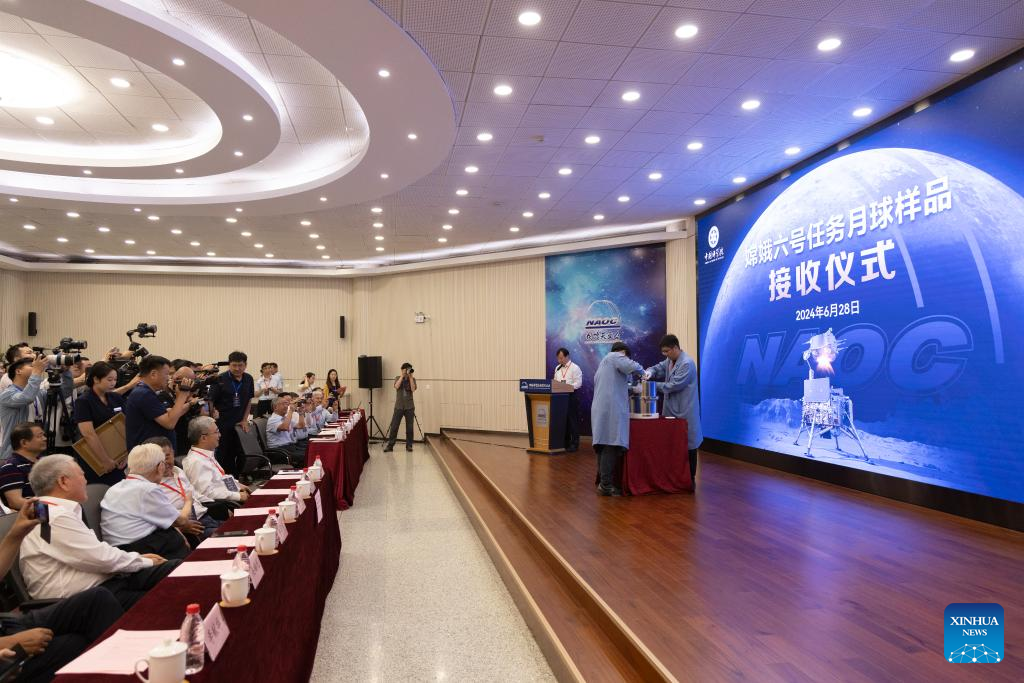
A reception ceremony for Chang'e-6 lunar samples is held at the National Astronomical Observatories under the Chinese Academy of Sciences (CAS) in Beijing, capital of China, June 28, 2024. A ceremony was held on Friday at the National Astronomical Observatories under the CAS to receive the lunar samples collected by China's Chang'e-6 probe. China's Chang'e-6 mission collected 1,935.3 grams of samples from the moon's far side, the China National Space Administration announced on Friday. (Xinhua/Jin Liwang)
China's Chang'e-6 mission collected 1,935.3 grams of samples from the far side of the moon, the China National Space Administration (CNSA) announced Friday.
Zhang Kejian, head of the CNSA, handed over the sample container to Ding Chibiao, vice president of the Chinese Academy of Sciences (CAS), along with the sample certificate at a ceremony held in Beijing.
Minister of Industry and Information Technology Jin Zhuanglong presided over the handover ceremony.
Based on preliminary measurement, the Chang'e-6 mission collected 1,935.3 grams of lunar samples, according to the CNSA.
"We have found that the samples brought back by Chang'e-6 were more viscous compared to previous samples, with the presence of clumps. These are observable characteristics," Ge Ping, deputy director of the CNSA's Lunar Exploration and Space Engineering Center, who is also the spokesperson for the Chang'e-6 mission, told the press at the ceremony.
Researchers will then carry out the storage and processing of the lunar samples as planned and initiate scientific research work.
The lunar samples, which were collected from the far side of the moon for the first time in human history, hold unique scientific significance as they will further enhance the understanding of lunar evolution, accelerate the pace of peaceful exploration and utilization of lunar resources, and serve as an important asset for all humanity, the CNSA said.
The CNSA vowed to continue to uphold the spirit of lunar exploration, characterized by "chasing dreams, daring to explore, collaborating to overcome challenges, and achieving win-win cooperation," to ensure the proper management of the samples.
It will organize scientific research on the samples, sharing China's lunar exploration achievements with the international community, the CNSA said.
Based on the lunar sample management rules released by the CNSA and the experience in dealing with the applications for lunar samples collected by the Chang'e-5 mission, applications for the Chang'e-6 samples are expected to open to domestic research institutions and scientists in about six months, Ge said.
Regarding international applications, Ge noted that China has always maintained a positive and open attitude and China welcomes scientists from all countries to submit applications in accordance with relevant procedures.
Previously, significant scientific achievements have been made through in-depth research on the lunar samples brought back by the Chang'e-5 mission, in areas such as lunar formation and evolution, space weathering, and resource utilization, the CNSA said.
Researchers have published more than 80 achievements in important domestic and international journals, including the discovery of the new lunar mineral Changesite-(Y), the sixth discovered on the moon, and the "youngest" basalt on the moon, which was determined to be about two billion years old and extended the "life" of lunar volcanism 800-900 million years longer than previously known.
The Chang'e-6 probe was launched into orbit on May 3. Its returner, carrying the lunar samples, landed precisely in its designated area in Siziwang Banner, north China's Inner Mongolia Autonomous Region on June 25, marking a complete success for the mission.
The Chang'e-6 returner safely arrived in Beijing later. Researchers opened it and successfully collected the lunar sample container on Wednesday, according to the CNSA. ■
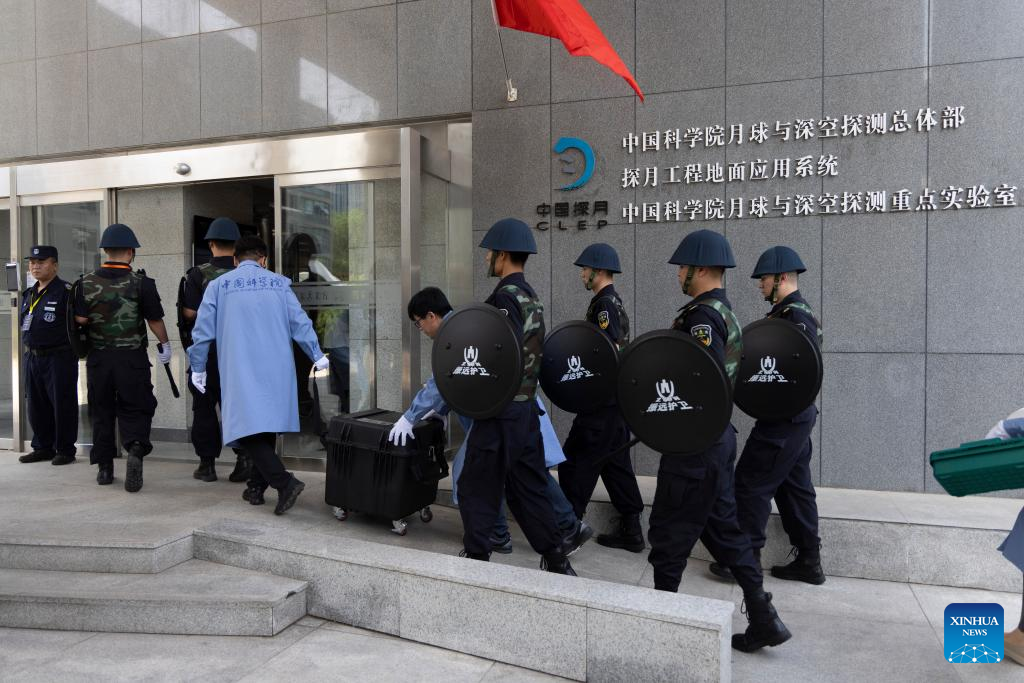
Staff members transfer Chang'e-6 lunar samples to the lunar and deep space exploration laboratory of the Chinese Academy of Sciences (CAS) in Beijing, capital of China, June 28, 2024. A ceremony was held on Friday at the National Astronomical Observatories under the CAS to receive the lunar samples collected by China's Chang'e-6 probe.
China's Chang'e-6 mission collected 1,935.3 grams of samples from the moon's far side, the China National Space Administration announced on Friday. (Xinhua/Jin Liwang)
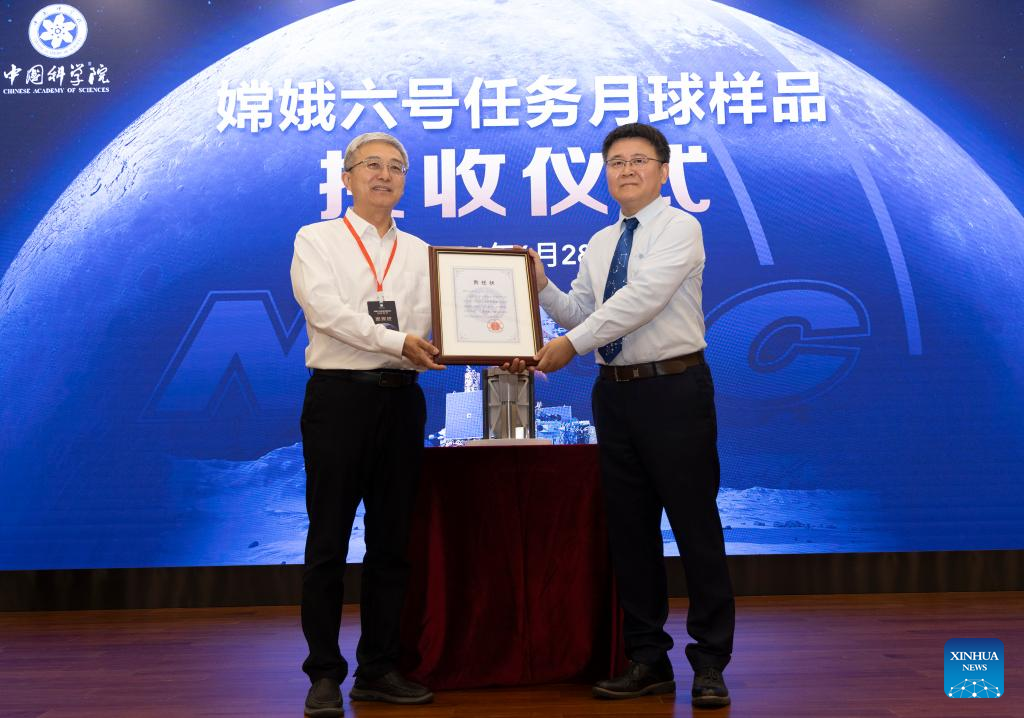
Ding Chibiao (L), vice president of the Chinese Academy of Sciences (CAS), issues a responsibility letter to Liu Jifeng, director of the National Astronomical Observatories, in Beijing, capital of China, June 28, 2024. A ceremony was held on Friday at the National Astronomical Observatories under the CAS to receive the lunar samples collected by China's Chang'e-6 probe.
China's Chang'e-6 mission collected 1,935.3 grams of samples from the moon's far side, the China National Space Administration announced on Friday. (Xinhua/Jin Liwang)
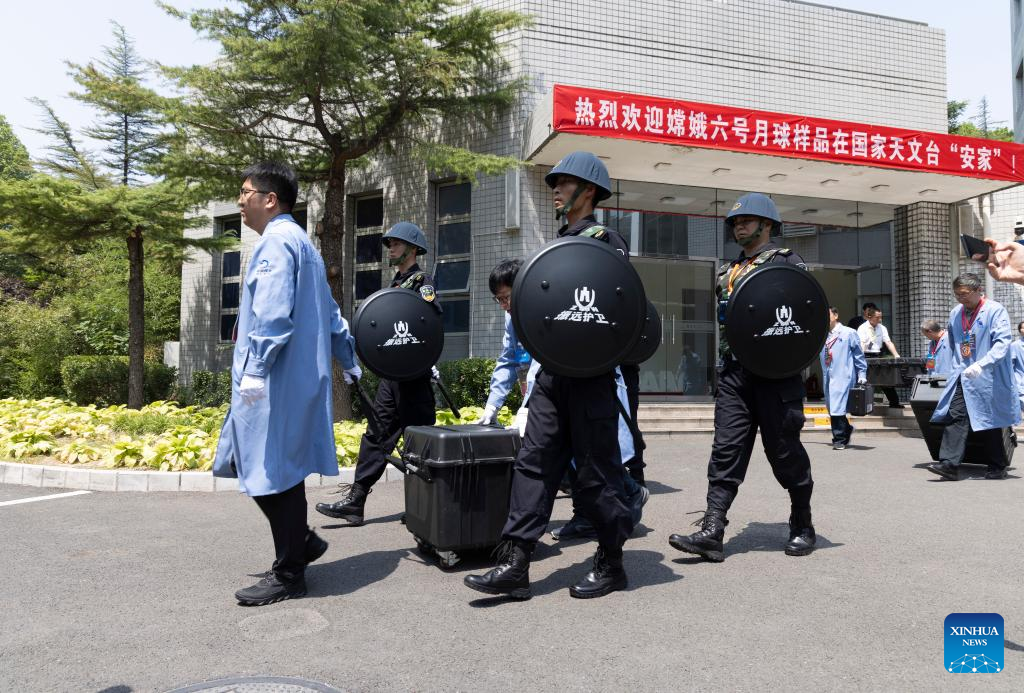
Staff members transfer Chang'e-6 lunar samples to the lunar and deep space exploration laboratory of the Chinese Academy of Sciences (CAS) in Beijing, capital of China, June 28, 2024. A ceremony was held on Friday at the National Astronomical Observatories under the CAS to receive the lunar samples collected by China's Chang'e-6 probe.
China's Chang'e-6 mission collected 1,935.3 grams of samples from the moon's far side, the China National Space Administration announced on Friday. (Xinhua/Jin Liwang)
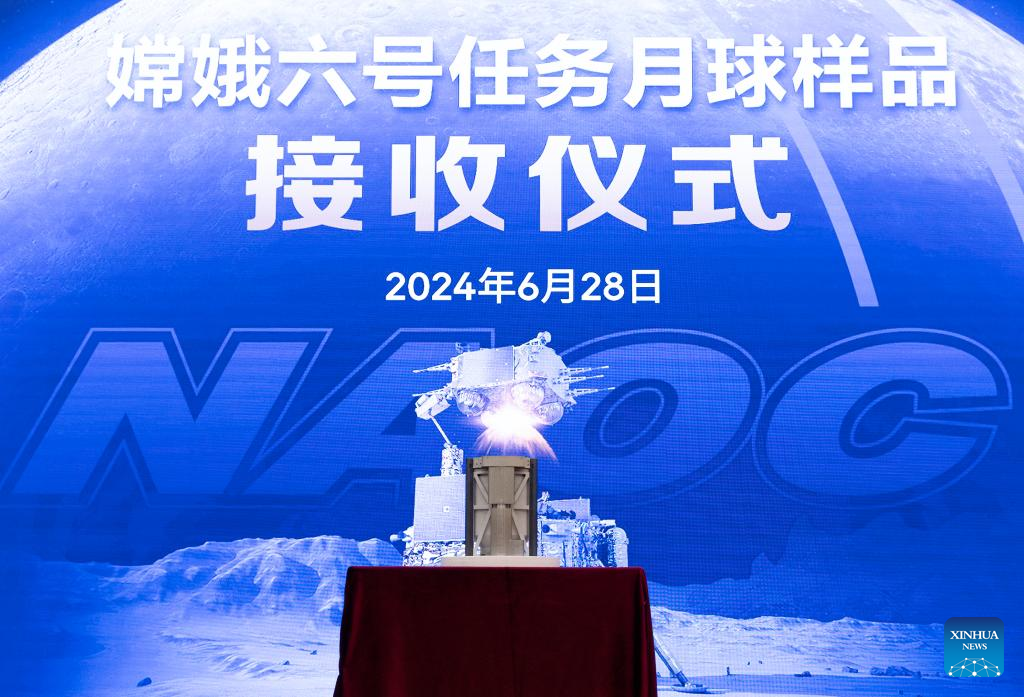
This photo taken on June 28, 2024 shows the container of Chang'e-6 lunar samples at the National Astronomical Observatories under the Chinese Academy of Sciences (CAS) in Beijing, capital of China. A ceremony was held on Friday at the National Astronomical Observatories under the CAS to receive the lunar samples collected by China's Chang'e-6 probe.
China's Chang'e-6 mission collected 1,935.3 grams of samples from the moon's far side, the China National Space Administration announced on Friday. (Xinhua/Jin Liwang)
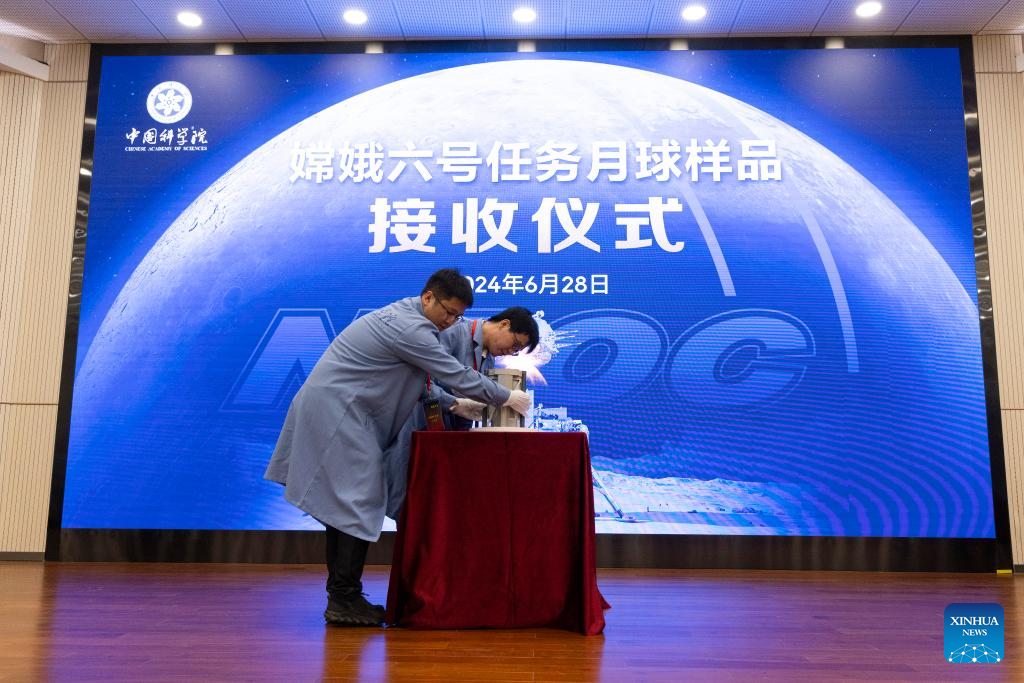
Staff members place the container of Chang'e-6 lunar samples at the National Astronomical Observatories under the Chinese Academy of Sciences (CAS) in Beijing, capital of China, June 28, 2024. A ceremony was held on Friday at the National Astronomical Observatories under the CAS to receive the lunar samples collected by China's Chang'e-6 probe.
China's Chang'e-6 mission collected 1,935.3 grams of samples from the moon's far side, the China National Space Administration announced on Friday. (Xinhua/Jin Liwang)
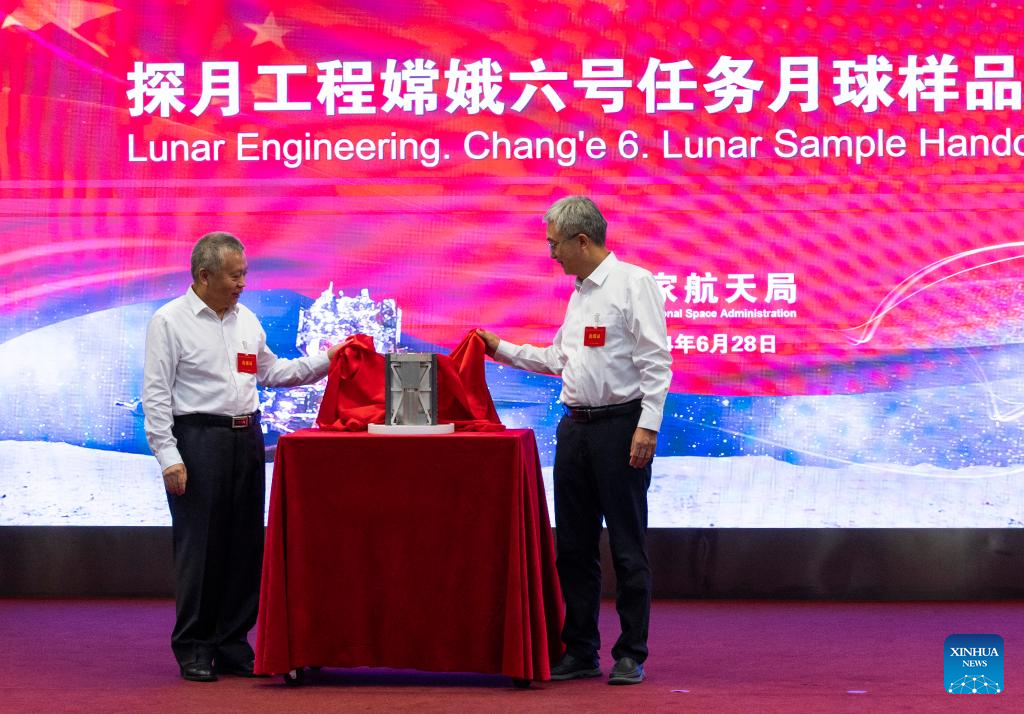
Zhang Kejian (L), head of the China National Space Administration (CNSA), and Ding Chibiao, vice president of the Chinese Academy of Sciences (CAS), unveil the sample container during the Chang'e-6 lunar sample handover ceremony in Beijing, capital of China, June 28, 2024.
China's Chang'e-6 mission collected 1,935.3 grams of samples from the far side of the moon, the China National Space Administration (CNSA) announced Friday.
Zhang Kejian, head of the CNSA, handed over the sample container to Ding Chibiao, vice president of the Chinese Academy of Sciences (CAS), along with the sample certificate at a ceremony held in Beijing.
Minister of Industry and Information Technology Jin Zhuanglong presided over the handover ceremony. (Xinhua/Jin Liwang)
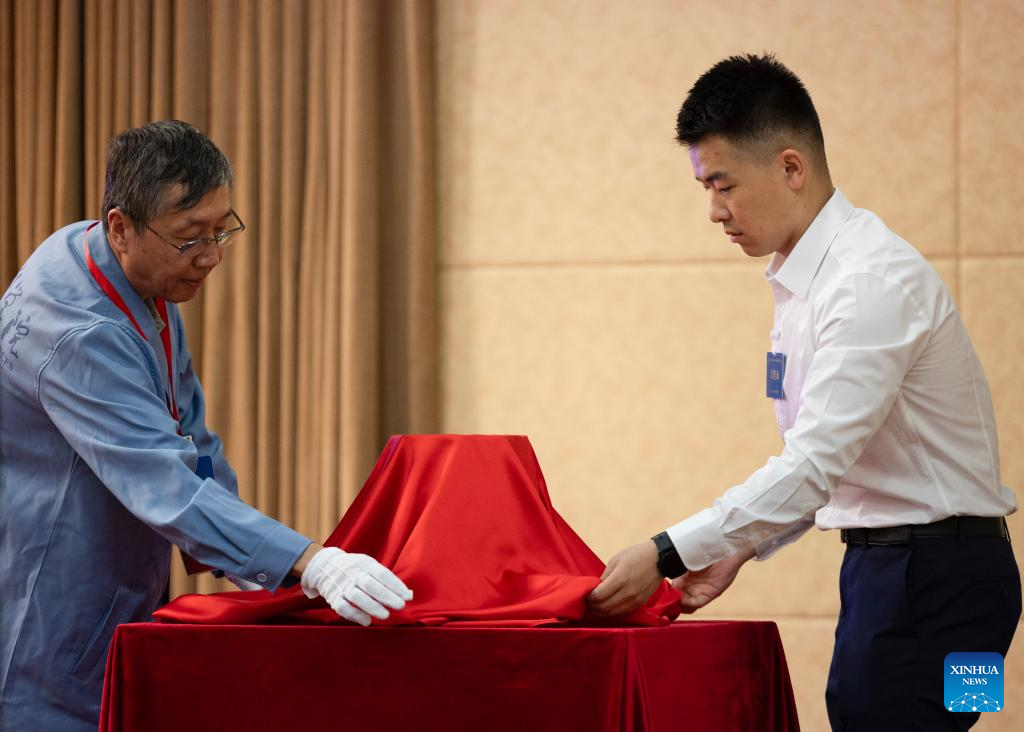
Staff members prepare for the Chang'e-6 lunar sample handover ceremony in Beijing, capital of China, June 28, 2024.
China's Chang'e-6 mission collected 1,935.3 grams of samples from the far side of the moon, the China National Space Administration (CNSA) announced Friday.
Zhang Kejian, head of the CNSA, handed over the sample container to Ding Chibiao, vice president of the Chinese Academy of Sciences (CAS), along with the sample certificate at a ceremony held in Beijing.
Minister of Industry and Information Technology Jin Zhuanglong presided over the handover ceremony. (Xinhua/Jin Liwang)
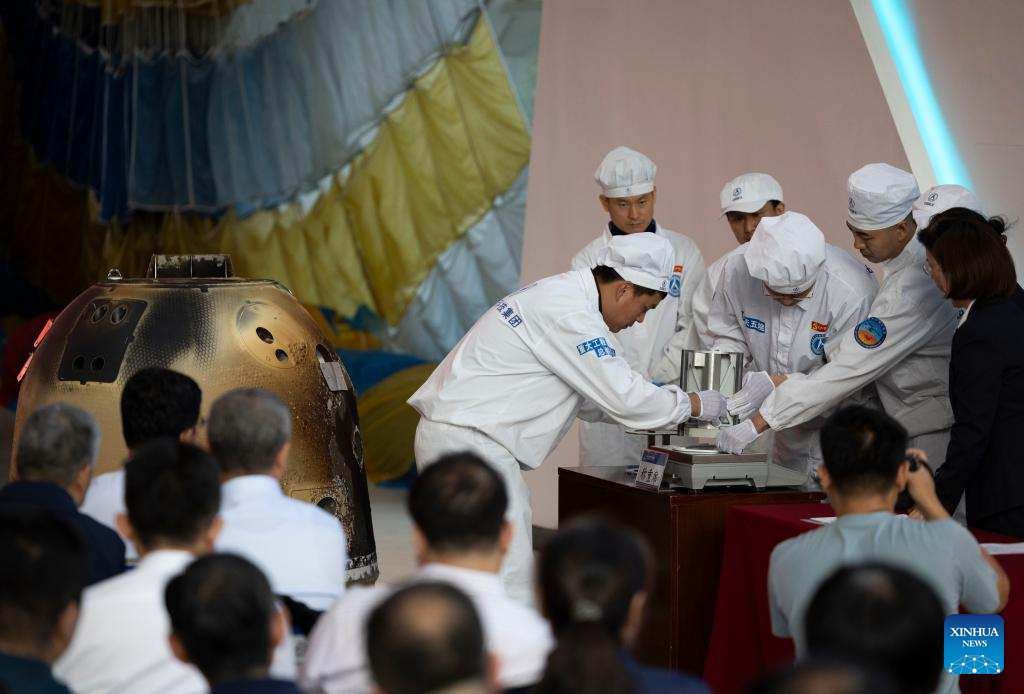
Researchers weigh the Chang'e-6 lunar samples during a returner opening ceremony at the China Academy of Space Technology under the China Aerospace Science and Technology Corporation in Beijing, capital of China, June 26, 2024.
China's Chang'e-6 mission collected 1,935.3 grams of samples from the far side of the moon, the China National Space Administration (CNSA) announced Friday.
Zhang Kejian, head of the CNSA, handed over the sample container to Ding Chibiao, vice president of the Chinese Academy of Sciences (CAS), along with the sample certificate at a ceremony held in Beijing.
Minister of Industry and Information Technology Jin Zhuanglong presided over the handover ceremony. (Xinhua/Jin Liwang)
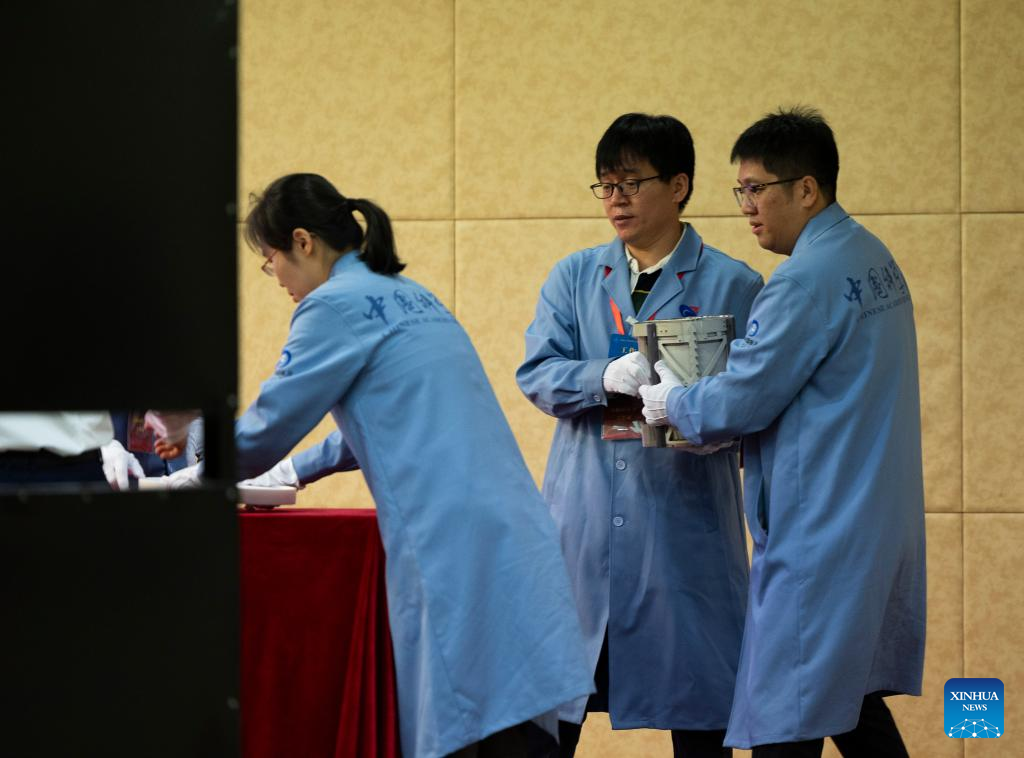
Staff members transfer the container of Chang'e-6 lunar samples in Beijing, capital of China, June 28, 2024.
China's Chang'e-6 mission collected 1,935.3 grams of samples from the far side of the moon, the China National Space Administration (CNSA) announced Friday.
Zhang Kejian, head of the CNSA, handed over the sample container to Ding Chibiao, vice president of the Chinese Academy of Sciences (CAS), along with the sample certificate at a ceremony held in Beijing.
Minister of Industry and Information Technology Jin Zhuanglong presided over the handover ceremony. (Xinhua/Jin Liwang)
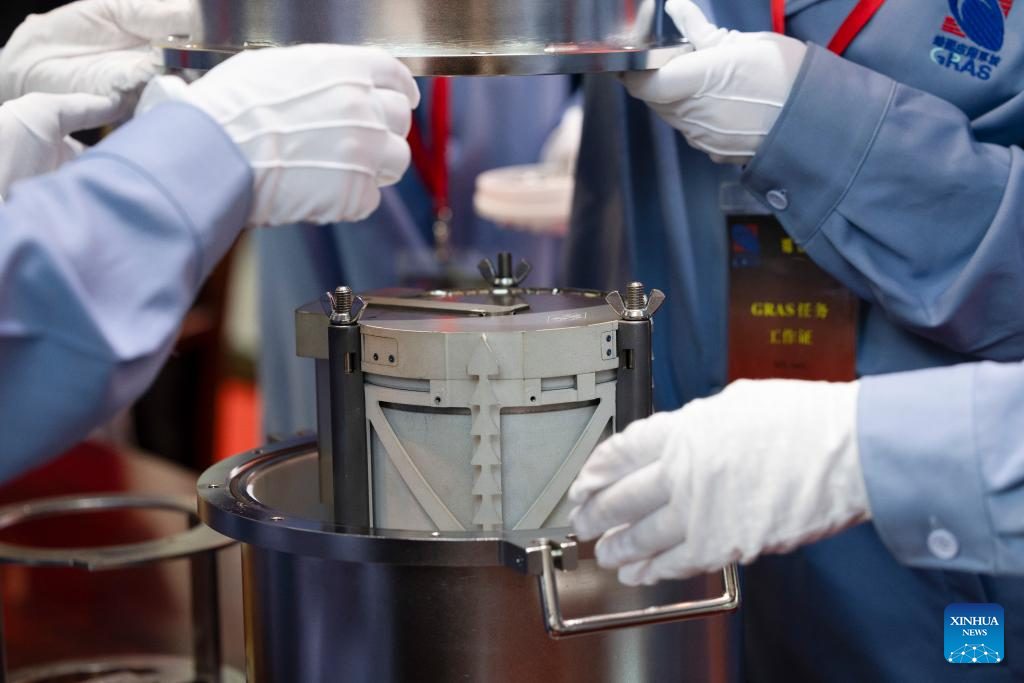
Researchers put the container of Chang'e-6 lunar samples into a protection case after a returner opening ceremony at the China Academy of Space Technology under the China Aerospace Science and Technology Corporation in Beijing, capital of China, June 26, 2024.
China's Chang'e-6 mission collected 1,935.3 grams of samples from the far side of the moon, the China National Space Administration (CNSA) announced Friday.
Zhang Kejian, head of the CNSA, handed over the sample container to Ding Chibiao, vice president of the Chinese Academy of Sciences (CAS), along with the sample certificate at a ceremony held in Beijing.
Minister of Industry and Information Technology Jin Zhuanglong presided over the handover ceremony. (Xinhua/Jin Liwang)
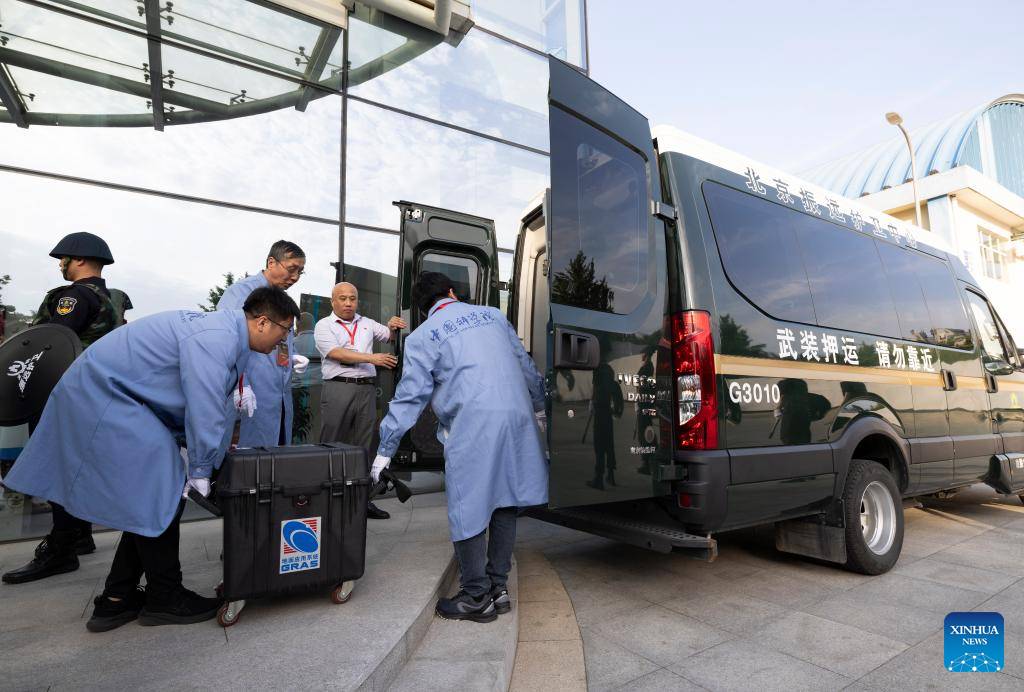
Researchers load the Chang'e-6 lunar samples onto a vehicle after a returner opening ceremony at the China Academy of Space Technology under the China Aerospace Science and Technology Corporation in Beijing, capital of China, June 26, 2024.
China's Chang'e-6 mission collected 1,935.3 grams of samples from the far side of the moon, the China National Space Administration (CNSA) announced Friday.
Zhang Kejian, head of the CNSA, handed over the sample container to Ding Chibiao, vice president of the Chinese Academy of Sciences (CAS), along with the sample certificate at a ceremony held in Beijing.
Minister of Industry and Information Technology Jin Zhuanglong presided over the handover ceremony. (Xinhua/Jin Liwang)
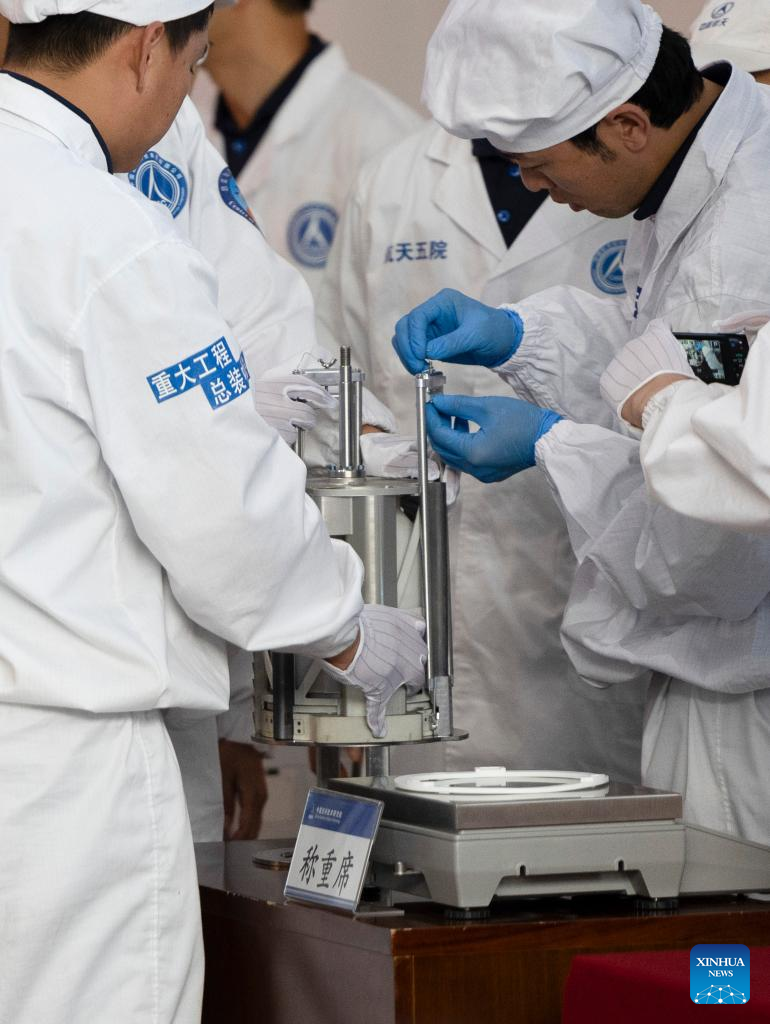
Researchers weigh the Chang'e-6 lunar samples during a returner opening ceremony at the China Academy of Space Technology under the China Aerospace Science and Technology Corporation in Beijing, capital of China, June 26, 2024.
China's Chang'e-6 mission collected 1,935.3 grams of samples from the far side of the moon, the China National Space Administration (CNSA) announced Friday.
Zhang Kejian, head of the CNSA, handed over the sample container to Ding Chibiao, vice president of the Chinese Academy of Sciences (CAS), along with the sample certificate at a ceremony held in Beijing.
Minister of Industry and Information Technology Jin Zhuanglong presided over the handover ceremony. (Xinhua/Jin Liwang)
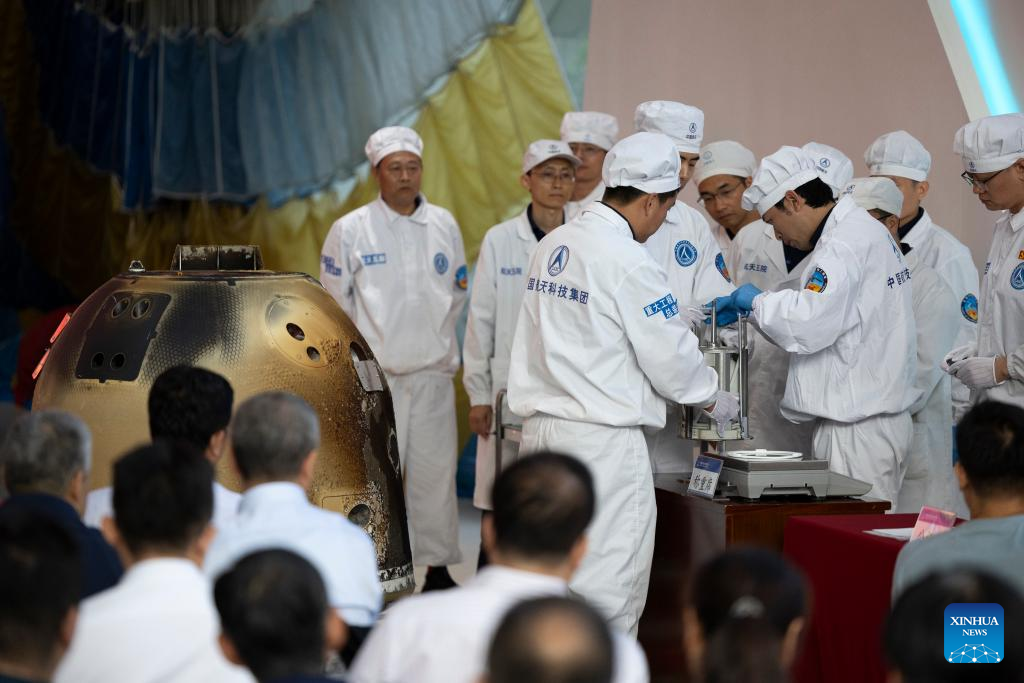
Researchers weigh the Chang'e-6 lunar samples during a returner opening ceremony at the China Academy of Space Technology under the China Aerospace Science and Technology Corporation in Beijing, capital of China, June 26, 2024.
China's Chang'e-6 mission collected 1,935.3 grams of samples from the far side of the moon, the China National Space Administration (CNSA) announced Friday.
Zhang Kejian, head of the CNSA, handed over the sample container to Ding Chibiao, vice president of the Chinese Academy of Sciences (CAS), along with the sample certificate at a ceremony held in Beijing.
Minister of Industry and Information Technology Jin Zhuanglong presided over the handover ceremony. (Xinhua/Jin Liwang)
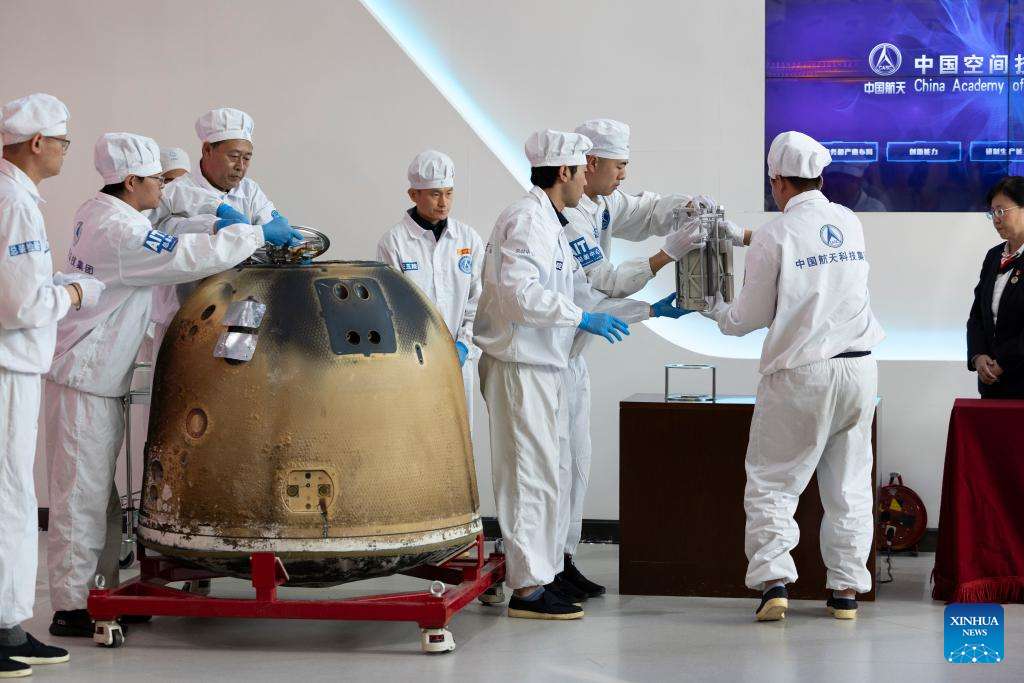
Researchers prepare to weigh Chang'e-6 lunar samples during a returner opening ceremony at the China Academy of Space Technology under the China Aerospace Science and Technology Corporation in Beijing, capital of China, June 26, 2024.
China's Chang'e-6 mission collected 1,935.3 grams of samples from the far side of the moon, the China National Space Administration (CNSA) announced Friday.
Zhang Kejian, head of the CNSA, handed over the sample container to Ding Chibiao, vice president of the Chinese Academy of Sciences (CAS), along with the sample certificate at a ceremony held in Beijing.
Minister of Industry and Information Technology Jin Zhuanglong presided over the handover ceremony. (Xinhua/Jin Liwang)
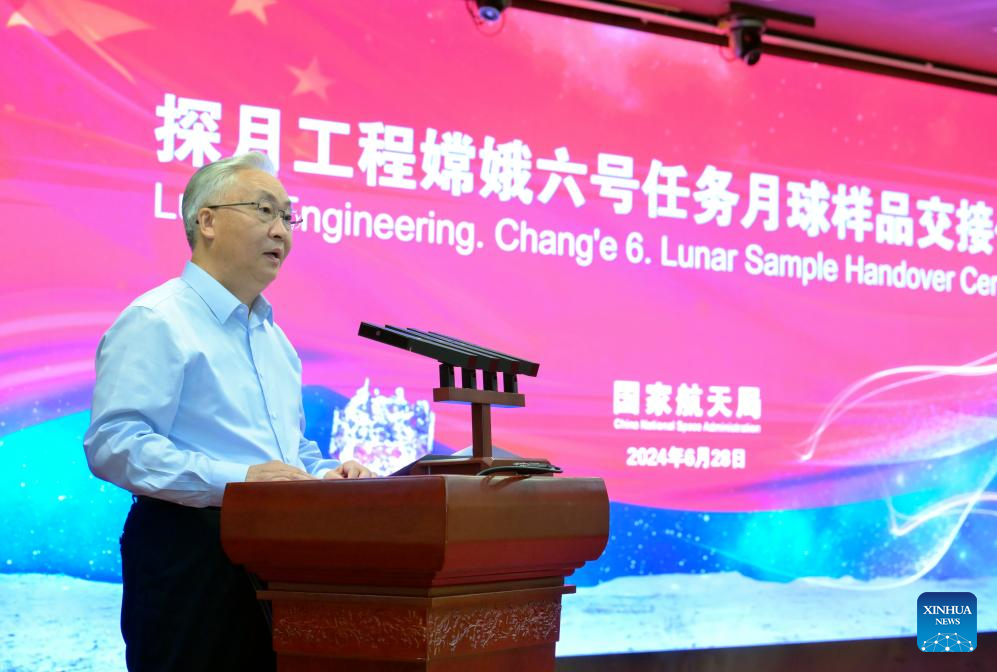
Chinese Vice Premier Zhang Guoqing, also a member of the Political Bureau of the Communist Party of China Central Committee, speaks while attending the handover ceremony of Chang'e-6 lunar samples in Beijing, capital of China, June 28, 2024. (Xinhua/Gao Jie)
Quelle: Xinhua
+++
China sets to expand int'l cooperation in lunar exploration missions
China is set to expand its international collaborations in upcoming lunar exploration endeavors following the successful operation of payloads from the European Space Agency (ESA), France, Italy, and Pakistan in China's Chang'e-6 mission.
The country's Chang'e-7 lunar exploration mission will carry six international scientific instruments, and Chang'e-8 will offer 200 kilograms of international payload capacity and has garnered over 30 applications, said Liu Yunfeng, deputy director of the China National Space Administration's (CNSA) international cooperation department.
The Chang'e-7 mission, scheduled for launch around 2026, is poised to survey the lunar south pole region. The Chang'e-8 probe will be launched around 2028 to carry out experiments on lunar resource utilization and, along with Chang'e-7, constitute the basic model of an international lunar research station by 2035.
The CNSA has signed cooperation documents with more than ten countries and international organizations on the International Lunar Research Station project, said Liu at a press conference on Thursday.
In the Chang'e-6 mission, China has fulfilled its commitment to allocate 10 kilograms of payload capacity on the lander and another 10 kilograms on the orbiter for international cooperation, said Hu Hao, chief designer of the Chang'e-6 mission, at the conference.
According to Liu, the international collaborative tasks in the mission have been going well. The French payload DORN worked for 32 hours, and ESA payload NILS worked for 3 hours and 50 minutes on the moon's surface.
Liu also said that the Italian laser retroreflector installed on top of the lander operated normally.
China delivered data provided by a CubeSat aboard its Chang'e-6 spacecraft to Pakistan on May 10. The cube satellite, ICUBE-Q, was developed by Pakistan's Institute of Space Technology and China's Shanghai Jiao Tong University.
"Despite differences in language, work culture, and developmental protocols, we have worked hand in hand to conduct an extensive array of tests over the past year and more and completed the task successfully," said Hu.
"The invaluable experience can enrich our expertise and prepare us to tackle even more sophisticated tasks in the future," Hu added.
Quelle: Xinhua
